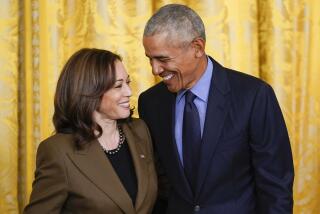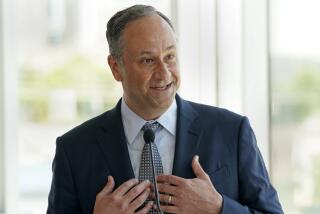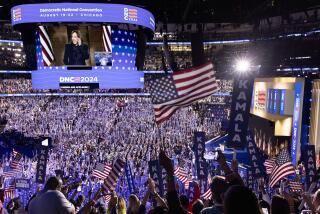IN SEARCH OF IDENTITY
- Share via
Nearly 4 1/2 years ago, Barack Obama introduced himself to America by painting a picture of a country that was united, somehow, in spite of itself.
The pundits, he said in the keynote address to the Democratic National Convention, like to “slice and dice” the country: red states for Republicans, blue states for Democrats.
“But I’ve got news for them too: We worship an awesome God in the blue states, and we don’t like federal agents poking around our libraries in the red states. We coach Little League in the blue states, and yes, we’ve got some gay friends in the red states.”
His task that night in Boston was to ready the crowd for the presidential nominee, John F. Kerry, but in the end his words were most memorable for an argument that challenged the partisan divide and was built on the foundation of his own unique story.
His father was from Kenya and his mother from Kansas. But it’s more complicated than that.
Abandoned by his father, separated for long periods from his mother, Obama searched for many years to find his identity. He eventually learned to navigate between black and white worlds. He earned a reputation as a pragmatist and a consensus builder, and along the way raised the bridges that would sustain his ambition.
Race has been the steady undertow of his political career -- and of his life.
As he paraphrased William Faulkner in March in a landmark speech on race: “The past isn’t dead and buried. In fact, it isn’t even past.”
--
Early years
Interracial relationships in Hawaii are an accepted fact of life. Nevertheless, the parents of Stanley Ann Dunham and Barack Hussein Obama didn’t like the idea of their children getting married. She was studying anthropology at the University of Hawaii. He was a graduate student from Kenya, the first African enrolled at the university.
They married in late 1960, and on Aug. 4, 1961, Barack Jr. was born. Two years after that, his father left to study economics at Harvard.
The separation led to divorce. Ann married Lolo Soetoro, an Indonesian student at the university. In 1967, she and her 6-year-old son, whom she called Barry, followed Soetoro to Jakarta, a strange and wonderful place of kite-flying and crocodiles, exotic foods and strange religions.
But the adventure had a darker side. The poverty was inescapable. Ann and Lolo drifted apart. She took a job teaching English at the U.S. Embassy, and it was here in the library, Obama said, that he read about a black man who had tried to peel off his skin.
Although his mother tried to affirm his black heritage -- bringing home books about the civil rights movement, speeches by Martin Luther King Jr. -- Barry was learning the price people pay for being different.
When he was 10, his mother sent him back to Hawaii to live with her parents and attend the prestigious Punahou School. On an island where there were few blacks, he watched “I Spy” on television, tried to sing like Marvin Gaye and cursed like Richard Pryor. He stayed out late, shooting hoops, and started to drink and smoke weed, he said, just to “push questions of who I was out of my mind.”
On the mainland, the reality of race was more stark.
As a scholarship student at Occidental College in Los Angeles in 1979, Obama faced assertions of identity everywhere: the Democrat/Socialist Alliance, Black Student Assn., Jewish Student Action Coalition, Movimiento Estudiantil Chicano de Aztlan.
He didn’t relate to the anger, the sense of marginalization, that other black students felt, and when he played along with popular stereotypes and assumptions, he realized he was living, in his words, “a lie.” One afternoon he was dissed by a friend for reading “a racist tract,” Joseph Conrad’s “Heart of Darkness,” an acclaimed novella about colonial Africa, and he pushed back.
“See. The book’s not really about Africa. Or black people. It’s about the man who wrote it. The European. . . . So I read the book to help me understand just what it is that makes white people so afraid. . . . That’s the only way to cure an illness, right? Diagnose it.”
As a man of mixed race, Obama was discovering his potential to negotiate both black and white worlds.
--
Turning point
Obama had come to see himself as a black American, yet still there was the question of his African heritage and his father, whom he had met only once in the last 21 years.
Obama left Occidental in 1981 to finish his degree in political science at Columbia University, in New York. He spoke with his mother about taking a trip to Kenya. She encouraged him, and then the phone rang.
“Barry? Barry, is this you?”
“Yes. . . . Who’s this?”
“Aunt Jane. Listen, Barry, your father is dead. He is killed in a car accident.”
Over the next few years, more alone than ever, Obama would learn how his father’s dreams of changing Kenyan society had foundered on harsh realities, leaving him burdened by family -- drinking and unhappy. Obama told Vanity Fair, “I do think that part of my life has been a deliberate attempt to not repeat mistakes of my father.”
He read more -- Nietzsche, Morrison, Melville and the Bible -- and stopped getting high. He ran three miles a day, fasted on Sundays and wrote “a journal of daily reflection and very bad poetry.” By 1984, he was working for a consulting firm, living on the Upper West Side and paying off his student loan.
On some days he would catch sight of himself -- suit and tie, briefcase in hand -- in the elevator doors and feel a rush of power and then, suddenly, remorse.
A friend who worked with Obama told David Mendell, author of “Obama: From Promise to Power,” that Obama always talked about the New Rochelle train, which “took commuters to and from New York City, and he didn’t want to be on one of those trains every day. The image of a life, not a dynamic life, of going through the motions . . . that was scary to him.”
When friends asked, he railed about the need for change with a capital C. He quit his consulting job and started working for a Ralph Nader group in Harlem. He passed out fliers for an assemblyman in Brooklyn. It was slow going. He was eating soup from a can.
Then he saw an ad looking for community organizers to help churches on Chicago’s South Side. In June 1985, he drove west in a beat-up Honda to a city where he knew no one. The job paid $10,000. He found an apartment in Hyde Park, a crossroads where blacks on the South Side mixed with whites from downtown.
Once settled, he headed farther south to the neighborhoods and churches of West Pullman and Roseland and to 131st Street, where every other home was boarded up.
Each congregation was an island unto itself, and as much as he tried to draw them together, the pastors were suspicious of his motives. One day he drove down to 95th Street and met the Rev. Jeremiah A. Wright Jr., who welcomed his help.
One Sunday, he went to Wright’s church not as an organizer but as a communicant. Here he met other black professionals whose spiritual dilemmas mirrored his own. As Wright preached his “Audacity of Hope” sermon -- with its tale of Hannah strumming her harp before a broken-down world -- Obama realized that after 25 years he had found the place he had been looking for, a place where he could “put down stakes and test [his] commitments.”
After almost three years in Chicago, he had worked his way into the community and in his memoir wrote that he felt he was on track to become “an example of black male success.” But he still felt “a more demanding impulse.”
In 1988, he enrolled at Harvard Law School to learn about “power’s currency in all its intricacy and detail.” He looked like a street tough -- with torn jeans, a cap hiding his afro, a pack of smokes and more life experience than most other students.
Still, he confounded his African American classmates. They had to persuade him to add his name to the list of candidates to oversee the university’s law review. And when he was elected president, the first black to hold the position, he disappointed those who assumed he would name more blacks and liberals to the board.
For the annual Supreme Court issue, he brought aboard the conservative Charles Freed and the critical race theorist Patricia Williams for the lead articles. When William J. Brennan Jr. announced his retirement, he published an assessment of the liberal justice’s career written by Richard Posner, a Ronald Reagan appointee to the 7th Circuit.
At the end of Obama’s tenure, in 1991, the other review editors included a parody of his life in the annual humor issue: “I was born in Oslo, Norway, the son of a Volvo factory worker and part-time ice fisherman. My mother was a backup singer for Abba. . . . At the age of 15, I went off to California to enroll at Accidental College. After a couple of years, I decided to go to Colombia, but when offered a position as a judge in Bogota, I fled to Chicago. There I discovered I was black, and I have remained so ever since.”
--
Marriage
Michelle LaVaughn Robinson grew up in a one-bedroom, one-bath apartment with her parents and an older brother on the South Side. She followed her brother to Princeton, where she studied sociology, ran a literacy program and turned the feelings of isolation that she and her friends felt as African Americans at the university into her senior thesis. She graduated from Harvard Law School in 1988, just before Obama arrived.
Obama met her in Chicago during a summer break from Harvard. He fell right in with the Robinsons, playing basketball with Michelle’s brother and enjoying the company of uncles and aunts who stopped by “to sit around the kitchen table and eat until they bust and tell wild stories and listen to Grandpa’s old jazz collection and laugh deep into the night.”
He had never experienced such a world, and one night he took Michelle to dinner and proposed. The ring arrived on a dessert plate.
Jeremiah Wright officiated at their wedding. Obama’s half-sister described the guests, whose backgrounds spanned the globe, as “the rainbow tribe . . . the united colors.”
Michelle started a new job in the mayor’s office, and he practiced law, taught at the University of Chicago, worked on Project Vote and wrote his memoir.
“Dreams From My Father” proved difficult to write. Initially conceived as a story about the challenges of African American identity, it soon drew him toward “rockier shores,” a more personal account of his experience of race.
Even though it initially sold only about 9,000 copies, it made him enough of a celebrity in Chicago that a political career suddenly seemed possible.
When Alice Palmer, who represented Hyde Park in the state Senate, endorsed Obama midterm in 1995 so that she could run for Congress, she called his candidacy the “passing of the torch.”
Nothing seemed to stand in his way. But when Palmer lost the Democratic congressional primary, she asked Obama to step aside so that she could run for reelection to her old seat. He refused. Too many friends and allies, white and black, had invested in him.
When Palmer filed a petition to have her name put on the ballot, he challenged the signatures. Irregularities were found, and in time Obama had the field to himself.
In January 1997, when he took his place among the other legislators in Springfield, he started building a network and taking arms, when necessary, against African American legislators eager to haze him over the Palmer affair.
“Senator, could you correctly pronounce your name for me?” asked one of them.
“Obama.”
“Is that Irish?”
“It will be when I run countrywide.”
Almost everyone tried to talk him out of running in the 2000 congressional race against Rep. Bobby L. Rush, a former leader of the Illinois Black Panther Party and a supporter of the late Harold Washington. Obama thought Rush was vulnerable after a recent defeat in a mayoral contest.
But President Clinton endorsed Rush. Rush earned sympathy from voters when his son was gunned down in a robbery. Then Obama’s 18-month-old daughter, Malia, fell ill, forcing him to miss an important vote on gun control. His opponents had a field day.
As the race neared its end, Obama was described as “the white man in blackface” and “the educated fool.” Rush beat him by a ratio of more than 2 to 1.
Of defeat, Obama wrote: “It’s impossible not to feel at some level as if you have been personally repudiated by the entire community, that you don’t quite have what it takes, and that everywhere you go the word ‘loser’ is flashing through people’s minds.”
By 2002, Obama seemed back on track. He had just been reelected to another four-year term as a state senator. He and Michelle and their two daughters were living in a comfortable condo in Hyde Park.
Still, something was missing. Perhaps he was nagged by the memory of his mother reminding him of greater responsibility. Or perhaps he simply saw an opportunity in the upcoming U.S. Senate race.
He brought aboard political consultant David Axelrod. He enlisted the support of Democratic legislators in Springfield, and he hit the road, making a key aspect of his campaign his opposition to the war in Iraq.
For nearly a year, he polled third in the field of Democrats. Then the cards fell his way. One opponent fell out of contention when his ex-wife alleged that he had threatened to kill her; another was stung by questions about his fundraising.
And when the Republican candidate had to withdraw four months after his primary victory -- divorce records revealed allegations that he had taken his ex-wife to sex clubs -- the GOP recruited Alan Keyes, a conservative black politician from Maryland.
Keyes attempted to peel off voters over wedge issues: school prayer, abortion, gay rights and affirmative action.
“Yes we can” -- a slogan suggested by Axelrod -- caught fire, and Obama’s address at the 2004 Democratic convention sealed the deal. He won with 70% of the vote, becoming just the fifth African American U.S. senator in history.
“Spooky good fortune” was how he described it.
--
Addressing race
The 2008 Democratic presidential contest was historic: a female candidate and a black candidate fighting a war of attrition, state by state. The issue of race came up, but the references were mostly veiled, and Obama stayed above the fray.
Then came the video clips on YouTube showing Obama’s pastor, Jeremiah Wright, raging against America (“No, no, no, not God bless America; God damn America!”), arguing among other things that the U.S. government was perpetrating genocide against African Americans.
Obama condemned Wright’s remarks. He wrote a column for the Huffington Post clarifying his position. Still the video played on.
He knew he had to respond. On a March evening in Philadelphia, he spoke to Americans about the elephant in the living room, the issue of race that “this nation cannot afford to ignore.” Instead of simply rejecting Wright’s claims, Obama once again borrowed from his past to tell a more complex story about America today.
“I can no more disown [Wright] than I can disown the black community,” he said. “I can no more disown him than I can my white grandmother, a woman . . . who once confessed her fear of black men who passed by her on the street. . . . These people are a part of me. And they are a part of America, this country that I love.”
The path to a more perfect union, he concluded, “requires all Americans to realize that your dreams do not have to come at the expense of my dreams.”
He was compared to Lincoln. He was compared to King.
Critics took him to task for not completely repudiating Wright. That would come after his loss to Hillary Clinton in Pennsylvania.
Then, he cast off Wright to save his campaign from a tempest that would only remind a nation of its deepest wounds. Once again, he had avoided the undertow.
--
This is an abridged version of an article originally published in The Times on Sept. 4.
More to Read
Get the L.A. Times Politics newsletter
Deeply reported insights into legislation, politics and policy from Sacramento, Washington and beyond. In your inbox three times per week.
You may occasionally receive promotional content from the Los Angeles Times.











